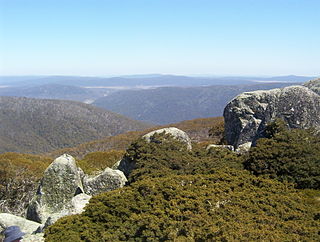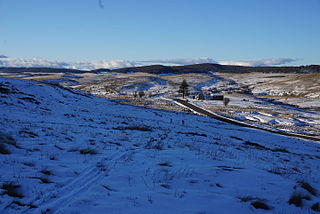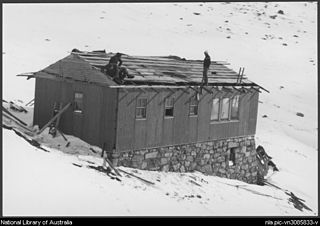
The Snowy Mountains, known informally as "The Snowies", is an IBRA subregion and the highest mountain range on the continent of mainland Australia. It contains the Australian mainland's highest mountain, Mount Kosciuszko, which reaches to a height of 2,228 m (7,310 ft) above sea level. The range also contains the five highest peaks on the Australian mainland, all of which are above 2,100 m (6,890 ft). They are located in southern New South Wales and are part of the larger Australian Alps and Great Dividing Range, experiencing large natural snowfalls every winter. Snow normally falls during June, July, August and early September, with the snow cover melting by late spring. The Tasmanian highlands makes up the other (major) alpine region present in Australia.

The Kosciuszko National Park is a 6,900-square-kilometre (2,700 sq mi) national park and contains mainland Australia's highest peak, Mount Kosciuszko, for which it is named, and Cabramurra the highest town in Australia. Its borders contain a mix of rugged mountains and wilderness, characterised by an alpine climate, which makes it popular with recreational skiers and bushwalkers.

Mount Kosciuszko, previously spelled Mount Kosciusko, is mainland Australia's tallest mountain, at 2,228 metres (7,310 ft) above sea level. It is located on the Main Range of the Snowy Mountains in Kosciuszko National Park, part of the Australian Alps National Parks and Reserves, in New South Wales, Australia, and is located west of Crackenback and close to Jindabyne.

The Australian Alps comprise an interim Australian bioregion, and are the highest mountain range in Australia. The range is located in southeastern Australia, straddling eastern Victoria, southeastern New South Wales, and the Australian Capital Territory. It contains Australia's only peaks exceeding 2,000 m (6,600 ft) in elevation, and is the only bioregion on the Australian mainland in which deep snow falls annually. The Alps comprise an area of 1,232,981 ha.

Thredbo is a village and ski resort in the Snowy Mountains of New South Wales, Australia, situated in a part of the Snowy Monaro Regional Council, and has been operated by Event Hospitality and Entertainment since 1987. It is about 500 kilometres (310 mi) south of Sydney, accessible by the Alpine Way via Cooma, Berridale, and Jindabyne. The village is built in the valley of the Thredbo River, also known as the Crackenback River, at the foot of the Ramshead Range.

Charlotte Pass, elevation 1,837 metres (6,027 ft), is a snow resort and village in the Snowy Mountains of New South Wales, Australia. The pass is in the Kosciuszko National Park where the Kosciuszko Road crosses Kangaroo Ridge. Charlotte Pass is the closest village to Mount Kosciuszko.

The Brindabella Range, commonly called The Brindabellas, is a mountain range located in Australia, on a state and territory border of New South Wales and the Australian Capital Territory (ACT). The range rises to the west of Canberra, the capital city of Australia, and includes the Namadgi National Park in the ACT and the Bimberi Nature Reserve and Brindabella National Park in New South Wales. The Brindabellas are visible to the west of Canberra and form an important part of the city's landscape.

Perisher Valley, commonly called Perisher, is a valley formed below Mount Perisher, a mountain that is located in the Snowy Mountains of New South Wales, Australia.

Blue Cow is a ski resort that is part of Perisher located in the Snowy Mountains of New South Wales, Australia, within the Snowy Monaro Regional Council. The resort is situated within the Kosciuszko National Park and is administered by the NSW National Parks & Wildlife Service. During winter months, the only access to the village is via the Skitube underground railway. In summer, access is via off-road only. Blue Cow is one of the four resort bases within Perisher, Australia's largest ski resort.

Mount Townsend, a mountain in the Main Range of the Great Dividing Range, is located in the Snowy Mountains region of New South Wales, Australia.

Jindabyne is a town in south-east New South Wales, Australia that overlooks Lake Jindabyne near the Snowy Mountains, in Snowy Monaro Regional Council. It is a popular holiday destination year round, especially in winter. This is due to its proximity to major ski resort developments within the Kosciuszko National Park, including Thredbo, Perisher and Charlotte Pass.

Selwyn Snow Resort is a ski resort located in the most northern part of the Snowy Mountains of New South Wales, Australia, in the Snowy Monaro Regional Council and Kosciuszko National Park. Selwyn Snowfields is located near the town of Adaminaby and is close to Cabramurra, which is the highest town in Australia.

Kiandra is an abandoned gold mining town and the birthplace of Australian skiing. The town is situated in the Snowy Mountains of New South Wales, Australia, in the Snowy Monaro Regional Council inside the Kosciuszko National Park. Its name is a corruption of Aboriginal 'Gianderra' for 'sharp stones for knives'. It was earlier called Gibson's Plains, named after Dr. Gibson, a settler in the district in 1839. For a century, Kiandra was Australia's highest town.

Guthega is a ski village and the site for a hydro electric dam located in the Kosciuszko National Park, on the upper reaches of the Snowy River, on the western face of Mount Blue Cow, Snowy Mountains of New South Wales, Australia.

Eucumbene Dam is a major gated earthfill embankment dam with an overflow ski-jump and bucket spillway with two vertical lift gates across the Eucumbene River in the Snowy Mountains of New South Wales, Australia. The dam's main purpose is for the generation of hydro-power and is one of the sixteen major dams that comprise the Snowy Mountains Scheme, a vast hydroelectricity and irrigation complex constructed in south-east Australia between 1949 and 1974 and now run by Snowy Hydro.

Mount Twynam is a mountain located on the Main Range, part of the Great Dividing Range, in the Snowy Mountains in New South Wales, Australia. The mountain is located close the border between New South Wales and Victoria.

Skiing in Australia takes place in the high country of the states of New South Wales, Victoria and Tasmania, as well as in the Australian Capital Territory, during the southern hemisphere winter.

Perisher Ski Resort is the largest ski resort in the Southern Hemisphere. Located in the Australian Snowy Mountains, the resort is an amalgamation of four villages and their associated ski fields, covering approximately 12 square kilometres (5 sq mi), with the base elevation at 1,720 metres (5,640 ft) AHD, and the summit elevation of 2,054 metres (6,739 ft) at the top of Mount Perisher. 4.4 square kilometres (1.7 sq mi) of this area is covered by 240 snow guns, which are used to artificially supplement the natural snowfall. Perisher was acquired by Vail Resorts, United States on 30 March 2015 for a sum of approximately AU$177 million.

Skiing in the Australian Capital Territory refers to snow skiing in the Australian Capital Territory (ACT). The highest mountain in the ACT is Bimberi Peak. Recreational skiing commenced with the formation of the Canberra Alpine Club in 1934. Since the 1930s, the ACT has had intermittent and limited alpine skiing facilities. Downhill ski facilities returned to the ACT at Corin Forest in 2016, after a two decade hiatus.

Lake Albina Ski Lodge was built overlooking Lake Albina in the Kosciuszko National Park of Australia, by The Ski Tourers Association,. In 1952 the first Albina Summer Slalom Cup was held, taking advantage of the seasonally unusual snow conditions. Summer time ski events continued for at least another 3 years on either Mount Kosciuszko or Mount Townsend. The National Parks and Wildlife Service (NPWS) required the club to vacate the lodge in 1969, and it gradually became a ruin. It was finally demolished by NPWS in 1983.






















